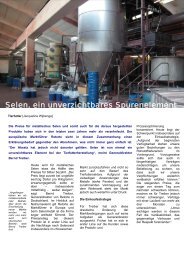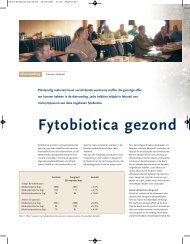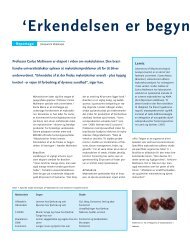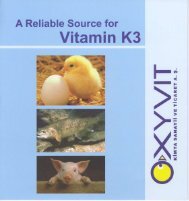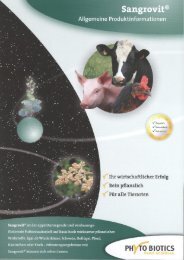Sangrovit - Jadis Additiva
Sangrovit - Jadis Additiva
Sangrovit - Jadis Additiva
Create successful ePaper yourself
Turn your PDF publications into a flip-book with our unique Google optimized e-Paper software.
Importance of bitter substances originating from<br />
<strong>Sangrovit</strong> as modulator between animal health and<br />
performance<br />
Dr. Kathrin Tschirner; Phytobiotics Feed Additives; Eltville; Germany<br />
Rennes, 11.06.2009
<strong>Sangrovit</strong> ® - An unique Product with approved Active Substances<br />
The Product<br />
Standardized, phytogenic feed additive<br />
Manufactured from one selected plant<br />
(Papaveraceae family)<br />
Defined, analysable active substances<br />
Scientific based, proven efficiency<br />
Documented Safety<br />
Transparent Production
<strong>Sangrovit</strong> ® - An unique Product with approved Active Substances
<strong>Sangrovit</strong> ® - An unique Product with approved Active Substances<br />
Active Principles<br />
Produced by the plant as defence substances<br />
(phytoalexines)<br />
Chemical classification: Benzophenanthridine alkaloids (BA)<br />
Functional classification: Bitter substances<br />
BA possess widespread biological activities<br />
Used in human/veterinary phytopreparations and dental care products since a long time<br />
Phytobiotics’ research shows that BA can impact animal performance and health<br />
Secondary plant metabolites
Bitter substances<br />
Definition: No defined chemical group, classification occurs in accordance to its function<br />
and taste<br />
MOA: Bitters bind to T2R-receptors (located on the tong ground) → release of calcium →<br />
release of neuro-transmitters → activation of the Nervus Vagus<br />
(Bitter taste receptors expressed mainly in the mouth, but also in the gastrointestinal<br />
tract 1 )<br />
Effects: stimulate digestive enzymes, gastric and pancreatic juice, increase appetite, have<br />
a general tonic action on digestion<br />
Bitter taste receptors react to very low concentrations<br />
(protection)<br />
1 S. V. Wu et al. (2002)
<strong>Sangrovit</strong> ® - Unique, known Mode of Action<br />
Stimulation of various digestive organs and functions<br />
Improved absorption of nutrients<br />
Improved liver function and health<br />
Anti-inflammatory properties<br />
Inhibition of enzymatic degradation of amino acids<br />
Higher growth performance (FI, FCR, DWG)<br />
Improved carcass quality<br />
Health promoting/stabilizing properties (e.g. lower<br />
mortality)
<strong>Sangrovit</strong> ® - Unique, known Mode of Action<br />
Improved liver<br />
health<br />
Stimulation<br />
digestion<br />
<strong>Sangrovit</strong><br />
Anti-inflammatory<br />
effects<br />
Amino Acids<br />
AADE<br />
Healthier Mucosa<br />
Better Absorption<br />
Higher<br />
Carcass value<br />
Stabilization of Immune-System<br />
Improved<br />
N-Balance<br />
Higher amino acid levels in the blood<br />
Higher availability of amino acids (e.g Trp)<br />
Amino Acids ⇑<br />
Nutrients for bacteria ⇓<br />
Indol, Skatol ⇓<br />
Less harmful substances<br />
at mucosa surface
Higher Availability of Amino Acids<br />
Plasma Lys Lys Concentration Concentration (µmol/l) (µmol/l)<br />
(µmol/l)<br />
600<br />
500<br />
400<br />
300<br />
200<br />
100<br />
0<br />
a<br />
a,b = significant differences<br />
Effect of <strong>Sangrovit</strong> Amino Acid Concentration in the Blood<br />
Lysine<br />
b<br />
Control <strong>Sangrovit</strong><br />
Institute of animal nutrition, University Kiel, Germany (2003)<br />
Plasma Plasma Try Try Try Concentration Concentration (µmol/l) (µmol/l) (µmol/l)<br />
70 70<br />
60 60<br />
50 50<br />
40 40<br />
30 30<br />
20<br />
10<br />
0<br />
a<br />
Tryptophan<br />
b<br />
Control <strong>Sangrovit</strong>
Higher Availability of Amino Acids - Impact<br />
Optimized AS metabolism<br />
Improved N-balance<br />
Lees urea in the blood → less detoxfication for the liver<br />
Improved N/Protein retention<br />
Better carcass quality and value<br />
…Special Impact of TRP<br />
Amino acid for protein metabolism<br />
Precursor for serotonin metabolism (►In the intestine, serotonin influences the<br />
secretion of digestive enzymes and the motility of the gut (Blundell, 1992)).<br />
Positive influence on protein metabolism in the liver (Peters, 1991)<br />
Supports liver health and liver metabolism in general<br />
Supports the immune system
Higher Availability of Amino Acids - Impact<br />
<strong>Sangrovit</strong> ® Improves N-Balance<br />
(Research Station HOECHST)<br />
Control Flavomycine <strong>Sangrovit</strong><br />
Weight gain, g/d 796 822 821<br />
FCR 2.24 2.20 2.16<br />
N excretion 100 94 91<br />
N retention 100 107 108<br />
N balance<br />
Urea blood<br />
100<br />
100<br />
106<br />
91<br />
109<br />
Ammonia blood 100 102 92<br />
Improved N-Retention and Balance<br />
Less Urea and Ammonia in the blood<br />
76<br />
<strong>Sangrovit</strong> ® Influences Serum Urea in lactating<br />
sows (University of Kiel, 2003)<br />
Urea Serum Serum concentration<br />
(mg/dl) (mg/dl)<br />
35<br />
30<br />
25<br />
20<br />
15<br />
10<br />
5<br />
***<br />
Control <strong>Sangrovit</strong><br />
30 ppm<br />
<strong>Sangrovit</strong> ® = Less Urea and Ammonia in the<br />
blood
Higher Availability of Amino Acids - Impact<br />
Effect of <strong>Sangrovit</strong> on carcass quality in pigs<br />
Institute of animal nutrition, University Kaunas, Lithuania (2003)<br />
120<br />
%<br />
110<br />
100<br />
90<br />
80<br />
70<br />
60<br />
*<br />
*<br />
Thickness of back<br />
fat<br />
* Significant differences<br />
*<br />
*<br />
Thickness of<br />
muscle meat<br />
Control = 100%<br />
<strong>Sangrovit</strong> (30 ppm)<br />
Proportion of<br />
lean meat<br />
Effect of <strong>Sangrovit</strong> on Lean Meat Percentage<br />
(Average of trials from 2002 – 2008)<br />
9 of 12 trials show an improved lean meat<br />
percentage due to <strong>Sangrovit</strong> supplementation<br />
Average: + 0.7% more lean meat
Anti-inflammatory effects of <strong>Sangrovit</strong><br />
► Literature data and own studies (next slide) show anti-<br />
inflammatory properties of <strong>Sangrovit</strong><br />
Where are these effects relevant?<br />
<strong>Sangrovit</strong> is not absorbed from the intestine → local effects<br />
the gut mucosa<br />
Impact of anti-inflammatory properties<br />
healthier intestinal mucosa ► better absorption of nutrients,<br />
minerals… ► lower demand of nutrients to fight against<br />
infections/inflammation<br />
promoting immune system ► intestinal tract is the biggest immune<br />
organ in the body<br />
Effect of <strong>Sangrovit</strong> and indomethacine<br />
on inflammation processes<br />
Inflammatory processes<br />
control =100%<br />
0<br />
-10<br />
-20<br />
-30<br />
-40<br />
-50<br />
(Lenfeld et al. 1981)<br />
<strong>Sangrovit</strong> QBA<br />
Indometacine<br />
0 1 2 3<br />
Time (h)
Anti-inflammatory effects of <strong>Sangrovit</strong><br />
Effects of <strong>Sangrovit</strong> on mucosa integrity<br />
(Prof. W. Gebreyes, North Carolina State University, USA, 2006)<br />
Method: Evaluation (In vitro; Ussing chambers) of Transepithelial Electrical<br />
Resistance (TER) as a parameter of mucosa thickness, integrity and<br />
inflammation processes.<br />
► Higher TER in the <strong>Sangrovit</strong> treatment indicates less<br />
inflammation and lesions and a healthier gut mucosa in general.<br />
Effects of <strong>Sangrovit</strong> on inflammation parameters<br />
(M. Quereshi, North Carolina State University, USA, 2004)<br />
Method: Determination of microphage nitrite production as an indicator of<br />
inflammatory processes.<br />
► Dose-dependent decrease in nitrite production<br />
► Less inflammation with higher concentration of <strong>Sangrovit</strong><br />
TER (ohms/cm²)<br />
80<br />
70<br />
60<br />
50<br />
40<br />
30<br />
20<br />
10<br />
0<br />
<strong>Sangrovit</strong><br />
(50 mg/kg)<br />
CTC<br />
(60 mg/kg)
Effect of <strong>Sangrovit</strong> on Gut Morphology<br />
<strong>Sangrovit</strong> cause a -20% lower weight of the intestine.<br />
► Thinner intestinal wall<br />
► Reduced inflammation<br />
► Better Absorption of nutrients<br />
At the same time the length was 10% higher.<br />
► More absorption surface<br />
► Higher capacity for synthesis of immune cells<br />
Chang Won Kang, Ph.D. Konkuk University Seoul, Korea, (2008)
Anti-inflammatory effects of <strong>Sangrovit</strong><br />
Effect of <strong>Sangrovit</strong> on absorption capacity<br />
Dr. J. Hoffmann, Agroproduct GmbH, Germany (2005)<br />
Method: Evaluation of yolk colour as parameter of absorption capacity<br />
Method of analyses<br />
* Significant difference (p
Feed/Feeding<br />
Health Performance
Impact of inflammation on protein turnover in different organs<br />
Mercier, s. et al. (2002). J. Nutr. 132, 1921-1928<br />
180<br />
%<br />
140<br />
120<br />
100<br />
80<br />
60<br />
40<br />
20<br />
0<br />
Control = 100%<br />
Inflammation<br />
(=Colitis)<br />
IIeum Colon Muscle<br />
Liver<br />
Chronic intestinal inflammations (e.g. colitis) increase the protein turn over/requirement of the<br />
intestinal mucosa at the expense muscle protein formation and daily growth .
Nutrients/Protein/AS requirement<br />
Deficit<br />
(Nutrients,<br />
AS…)<br />
Nutrients/Protein/AS delivered by the diet<br />
► decreased performance<br />
► reduces health status<br />
► higher mortality<br />
Stress /Infection pressure/Health problems…<br />
<strong>Sangrovit</strong><br />
in the diet<br />
2<br />
2<br />
Reduced<br />
deficit<br />
► less reduction in performance<br />
► healthier animals<br />
► reduced mortality<br />
low high low<br />
low high<br />
low<br />
1<br />
Stress /Infection pressure/Health problems…<br />
Lower and shorter infection processes due to <strong>Sangrovit</strong>‘s<br />
anti-inflammatory effects<br />
1<br />
Higher protein/amino acid availability from the feed due to<br />
<strong>Sangrovit</strong> (amino acid protection; increased nutrient availability,<br />
better nutrient absorption)
<strong>Sangrovit</strong> during a three week lactation<br />
Objective<br />
Does <strong>Sangrovit</strong> increase the litter weight at weaning?<br />
Method:<br />
Place: farm with 400 sows in Germany, 2003<br />
Treatments: Control; <strong>Sangrovit</strong> 30 mg/kg<br />
Animals: 105 sows (parity 1 – 9)<br />
Diet: 13.8 MJ/kg; 17.5 % CP; 9.0 g Lys/kg<br />
Parity (lactation number) class<br />
PC1 = Parity 1<br />
PC2 = Parity 2<br />
PC3 = Parity 3-6<br />
PC4 = Parity 7-9
<strong>Sangrovit</strong> during a three week lactation<br />
Litter weight gain [kg] – All sows (PC 1-4) LSmeans ± SEM<br />
Day 1-10*<br />
Day 11-20*<br />
Day 1-20*<br />
C (n=35)<br />
21.4 ± 0.7<br />
22.8 ± 0.7<br />
44.0 ± 1.1<br />
* T x PC (Treatment x Parity class) effect p
<strong>Sangrovit</strong> during a three week lactation<br />
60<br />
kg<br />
50<br />
45<br />
40<br />
35<br />
30<br />
Litter weight gain [kg] in first and second litter sows<br />
First Litter Sows (PC 1)<br />
C S30<br />
(PC1 and 2; LSmeans ± SEM)<br />
+ 10%<br />
60<br />
kg<br />
50<br />
45<br />
40<br />
35<br />
30<br />
Second Litter Sows (PC 2)<br />
a<br />
a,b significant differences<br />
+13 %<br />
+ 13,5%<br />
b<br />
C S30<br />
Higher litter weight gain was observed in first and second litter sows treated with <strong>Sangrovit</strong>.<br />
<strong>Sangrovit</strong> has a positive effect particularly in young sows that are typically affected by two<br />
types of stress at the same time: Their own growth and milk production.<br />
a<br />
b
<strong>Sangrovit</strong> in combination with Organic acids (1)<br />
Britsh Quality Pork, Great Britain 2007<br />
Trial duration: 64 days (45-110 kg body weight)<br />
Treatment:<br />
control<br />
control + Benzoic acid (5 kg/t) (+BA)<br />
control + Benzoic acid (5 kg/t) + <strong>Sangrovit</strong> (30 mg/kg) (+BA + <strong>Sangrovit</strong>)<br />
4 recurrences per treatment<br />
(4 x 5 animals, 2 sows and 3 boars respectively)
<strong>Sangrovit</strong> in combination with Organic acids (2)<br />
Effect of <strong>Sangrovit</strong> on fattening performance<br />
(Total fattening period 48-110 kg, 64 d)<br />
Total weight gain, 64 days of fattening<br />
control: 60,15 kg, control + BA:61,3 kg, control + BA + <strong>Sangrovit</strong>: 66,62 kg
Summary: Effect of <strong>Sangrovit</strong> in Growing/Fattening pigs 1<br />
Daily weight gain<br />
(in relation to the control group = 100%)<br />
<strong>Sangrovit</strong><br />
+3.3%<br />
1 Average of 30 trials around the world over last 6 years<br />
FCR<br />
(in relation to the control group = 100%)<br />
<strong>Sangrovit</strong><br />
- 3.8%
<strong>Sangrovit</strong> for Piglets – Meta-Analysis (1) 1<br />
Effect on Fed intake<br />
1 Results of 5 trials on efficacy of <strong>Sangrovit</strong> ® in weaned piglets: IRTA , Spain, 2007/2008; IRTA, Spain, 2008; Provimi, Netherlands, 2007;<br />
UWM, Poland, 2008; Kaposvar, Hungary, 2008; Treatment groups: Control, <strong>Sangrovit</strong> 15 mg/kg; <strong>Sangrovit</strong> 30 mk/kg; <strong>Sangrovit</strong> 60 mg/kg<br />
2 <strong>Sangrovit</strong> = S<br />
2
<strong>Sangrovit</strong> for Piglets – Meta-Analysis (2) 1<br />
Effect on Weight gain<br />
1 Results of 5 trials on efficacy of <strong>Sangrovit</strong> ® in weaned piglets: IRTA , Spain, 2007/2008; IRTA, Spain, 2008; Provimi, Netherlands, 2007;<br />
UWM, Poland, 2008; Kaposvar, Hungary, 2008; Treatment groups: Control, <strong>Sangrovit</strong> 15 mg/kg; <strong>Sangrovit</strong> 30 mk/kg; <strong>Sangrovit</strong> 60 mg/kg<br />
2 <strong>Sangrovit</strong> = S<br />
2
<strong>Sangrovit</strong> for Piglets – Meta-Analysis (3) 1<br />
Effect on FCR<br />
1 Results of 5 trials on efficacy of <strong>Sangrovit</strong> ® in weaned piglets: IRTA , Spain, 2007/2008; IRTA, Spain, 2008; Provimi, Netherlands, 2007;<br />
UWM, Poland, 2008; Kaposvar, Hungary, 2008; Treatment groups: Control, <strong>Sangrovit</strong> 15 mg/kg; <strong>Sangrovit</strong> 30 mk/kg; <strong>Sangrovit</strong> 60 mg/kg<br />
2 <strong>Sangrovit</strong> = S<br />
2
Summary: <strong>Sangrovit</strong> for Piglets<br />
Daily weight gain<br />
(in relation to the control group = 100%)<br />
<strong>Sangrovit</strong><br />
+ 4.4%<br />
FCR<br />
(in relation to the control group = 100%)<br />
<strong>Sangrovit</strong><br />
- 3.3%
<strong>Sangrovit</strong> is a clear defined standardized product<br />
Well described mode of action<br />
Health promoting properties lead to an increased performance<br />
Anti-inflammatory effects<br />
Liver protection<br />
Amino acid sparing effect<br />
Improved FCR<br />
Higher daily weight gain<br />
Higher carcass value and quality<br />
Constant performance and stability
Thank you very much for<br />
your attention!<br />
Don’t worry…. Be happy with <strong>Sangrovit</strong>!



